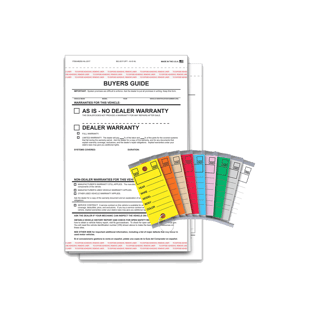
Terminating an Employee? Things to Consider to Avoid Litigation
Terminating an employee is never easy. Whether the decision is driven by an employee’s performance problems or misconduct, or the company’s economic condition or shifting organizational priorities, no one likes to deliver the termination message. Nevertheless, most employers will need to communicate this message at least once, and usually on multiple occasions, to members of their workforce.
PARTNER SPOTLIGHT
Dealer Management System, Computer Technology, Media/Advertising, Automotive Auction, F & I/Aftermarket Products, Automotive Technology Training & Compliance
 A NHADA Gold PARTNER
A NHADA Gold PARTNERComputer Technology, Automotive Shop Equipment, Environmental Services
 A NHADA Platinum PARTNER
A NHADA Platinum PARTNERF & I/Aftermarket Products, Automotive Technology Training & Compliance, Environmental Services
.png?width=150&name=corp_logo_horz_on_light_with_trademark_symbol_1200w%20(002).png) A NHADA Diamond PARTNER
A NHADA Diamond PARTNERF & I/Aftermarket Products, Financial Services, Automotive Technology Training & Compliance
 A NHADA Diamond PARTNER
A NHADA Diamond PARTNERIn order to make the termination meeting go as smoothly as possible, it is best to be prepared. Even where an employee is employed “at-will,” it is best to spend time carefully reviewing and planning for the termination meeting. By adopting some pre-termination protocols, employers can reduce the risk that employees will believe they were terminated for an unlawful reason and pursue litigation. With that in mind, employers should consider the following:
Before the termination – confirm the reason for the termination:
- Review any applicable employment contracts, collective bargaining agreements or offer letters to confirm whether the employment is at-will, or whether some other standards for termination apply.
- Even when the employee is employed “at-will,” which means the employer can terminate the employee for any reason, or no reason, with or without cause, it is usually best to terminate for a reason related to performance, conduct, or an economic reason. Having a legitimate reason for termination is helpful to avoid litigation and to foster a productive culture.
- If the employee has reportedly violated a policy, review all applicable employment policies to be sure that the policy or standard the employee violated is clear, and that you have adhered to any required procedures. Likewise, if the termination is tied to a performance issue, review the job description and any performance evaluations to confirm the employee has received proper notice of expectations.
- Gather and review all of your documentation about the employee including the personnel file and any notes, emails, or other records.
- Be sure to base your decision on information in the documentation and not on speculation or suspicion. If you do not have personal knowledge of the information in the documentation, do some due diligence to be sure that the documentation and any other information is accurate and provides you with the complete picture -- including the employee’s side of the story.
- Make sure the employee has had notice of and an opportunity to respond to any allegations of misconduct or poor performance and has been permitted time to improve sub-par performance. Notice of a problem and an opportunity to fix it is a workplace expectation for most employees. Ideally, an employee should not be surprised by a termination meeting.
- Review your organization’s prior disciplinary history to ensure that this employee is treated consistently.
- Assess if the employee is a member of a legally protected category (e.g., race, color, religion, national origin, sex, etc.), has engaged in any protected activity (e.g., recent medical leave, filed a harassment or whistleblower complaint, etc.) or otherwise presents a risk for litigation (e.g., wage claims).
- Review the termination decision with a third party such as an employment lawyer, Human Resources, or another member of management.
- Plan the termination meeting, including who will attend and what will be communicated. Draft a termination “script” and stick with it. It is important to communicate a clear message that a decision has been made.
- Prepare the employee’s final paycheck and, if applicable, a check for unused vacation or other paid time, as well as the federal COBRA notice (or notice of state law continuation coverage for employers with fewer than 20 employees).
- Prepare a written termination letter to give to the employee, and consider having the letter reviewed by counsel in advance.
- Decide whether to offer severance benefits in exchange for a release and waiver of claims. Generally, severance benefits are not required, but an employer may elect to offer severance for litigation risk management purposes.
During the termination meeting with the employee – convey a clear message:
- If possible, it is best to hold the meeting in person, with two people present in addition to the employee. If you’d like, you may offer the employee the option to “resign in lieu” of termination. It may help the employee transition to new employment quicker.
- Communicate the company’s decision in a kind, direct, and respectful manner. It is usually best to provide the employee with the reason(s) for termination, even if you are an at-will employer.
- Confirm when the employee will receive payment for final wages and any benefits continuation information, and invite the employee to call you with any questions about COBRA or other benefits.
- Offer an after-hours (supervised) time for the employee to pack personal belongings.
- Get the employee’s key, phone, computer, and any other employer property, and disable the employee’s computer access promptly.
- Provide a written termination letter; although not legally required in New Hampshire, it is a best practice.
After the termination – be prepared for next steps:
- Consider not contesting the employee’s application for unemployment compensation benefits. Former employees who are denied benefits are more likely to pursue other legal options.
- After terminating an employee, be prepared to advise other employees about the change and where to direct questions or work that would have previously been handled by the discharged employee. Employers need to carefully balance explaining why an employee is no longer a part of the workplace with protecting the former employee's right to privacy and reputation.
- If you receive a request for a reference for the terminated employee, follow your reference policy, which for most employers means confirmation of dates of employment and position held.
If you still have questions, please contact Peg O’Brien at Margaret.OBrien@McLane.com or any member of NHADA Silver Partner McLane Middleton's Employment Law Practice Group.


















.png?width=150&name=Ally_Final%20Logos%20and%20Pairings_11.14.2018-01%20(2).png)


-2.png?width=150&name=Wipfli%20Logo%20Blue%20RGB%20(1)-2.png)


.jpg?width=150&name=NHADA_Partner_FTR_Img_NHADA_Insurance%20(1).jpg)


.jpg?width=150&name=NHADA_Partner_FTR_Img_JMA(1).jpg)






